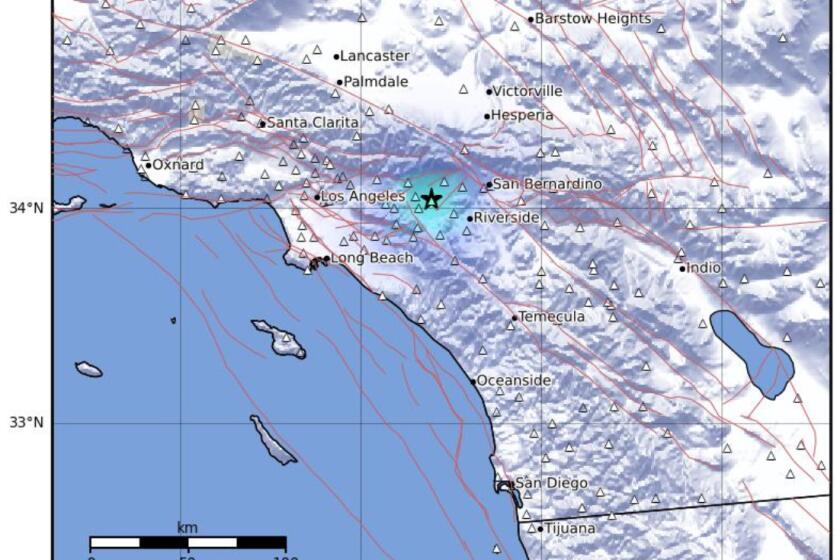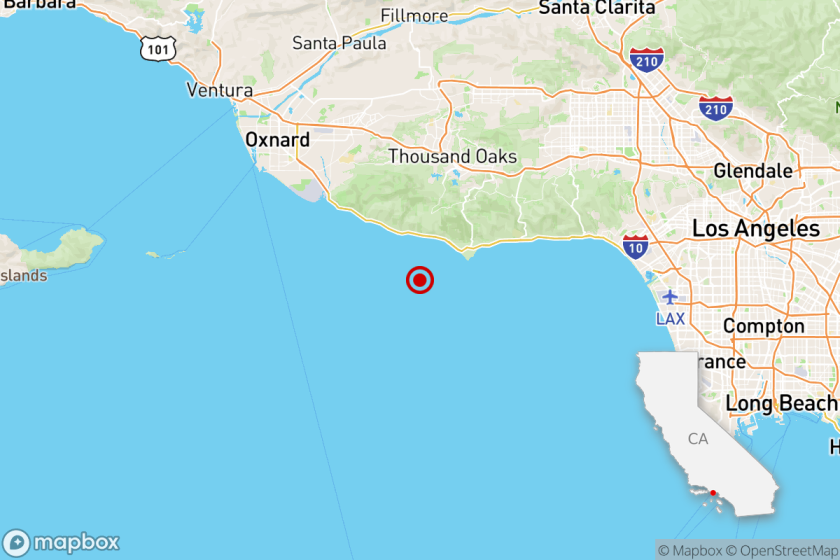Readiness Pays for Hospital at Epicenter
When the tales are told about the Great Quake of January, ‘94, Bill Pringle Jr. and the rest of the crew at Northridge Hospital Medical Center will have among the best of all.
Working in a trauma center at ground zero when the magnitude 6.6 Northridge earthquake struck, they hauled babies out of their intensive care unit incubators and brought them through wobbly, darkened stairwells to safety, and set up makeshift triage centers to treat seriously wounded quake victims in the pre-dawn chill of the parking lot.
“It was pandemonium,” said Pringle, an emergency room nurse. “That we were at the epicenter and could still take care of people--it was a miracle.”
But it was not a miracle. Northridge’s seeming luck can be traced to many factors: a well-prepared staff, a well-designed building and an earthquake that struck in the pre-dawn hours.
Most significant, the hospital had been retrofitted to meet state regulations requiring hospitals built after 1973 to be earthquake resistant not only on the outside, but on the inside as well. Hospital officials had reinforced and braced the necessary mechanical, electrical and medical gas systems. By contrast, hospitals without such reinforcements found themselves unable to treat patients, and in some cases having to evacuate them to other hospitals.
As many as one in five acute-care hospitals in the state run a “potentially high” risk of failing in an earthquake because they do not meet quake reinforcing rules, according to the latest state report.
Northridge Hospital Medical Center’s survival and the response of its staff are already being studied by the many experts eager to learn lessons from the quake.
State scientific teams and government investigators have pored over every crack and crevice of the building at Roscoe and Reseda boulevards to determine why the hospital stayed operable through such a monstrous pounding while others farther away did not.
Experts also will be studying how the hospital’s preparedness plan and the quick and cool staff response allowed hundreds of panicked people to be treated for serious injuries starting four minutes after the earth’s upheaval. Many of those treated for heart attacks, artery lacerations and other serious injuries might have gone without life-saving medical aid if the hospital had not taken precautions to bolster its infrastructure.
The 21 premature infants in the neonatal ICU ward--including the tiniest, Baby Girl Scammell--could have died had the building and its infrastructure faltered even for a short while. Patients in the adult intensive care unit would have been at similar risk without operating life support systems, hospital officials said. At the other San Fernando Valley trauma center, Holy Cross Medical Center in Mission Hills, a patient died when the quake knocked out power to his ventilator, coroner’s officials said.
On Friday, Assemblyman Burt Margolin (D-Los Angeles) joined a number of state officials who have called for costly earthquake retrofitting of all hospitals so they can continue operating when a major earthquake hits.
Only hospitals built since 1973 need to adhere to special earthquake-resistant codes. Fears of astronomical costs resulted in exemptions for older hospitals until they remodeled or expanded. Starting in 1983, guidelines requiring that internal hospital systems be made earthquake resistant went into effect.
Many experts cited the example of Northridge, which with its cracked walls and floors nevertheless was running at close to normal within hours of the quake, as evidence that retrofitting can make the difference.
“The proof is in the pudding. . . . The codes do work,” said Shell Culp, a spokeswoman for the Office of Statewide Health Planning and Development.
“You would think that since these codes have been around for 20 years that other hospitals would have brought themselves up to the code. But there isn’t anything in the law to make them do that,” Culp said. “So now they’re biting it, I guess.”
The Hospital Seismic Safety Act was enacted in response to the 1971 Sylmar earthquake, which left 50 dead in two hospital collapses. By 1990, state officials reported that 21% of the acute care hospitals statewide still had potentially high seismic risk. In the zone encompassing Southern California, 358 buildings housing 18,458 beds would “probably not remain functional,” the report concluded.
State officials declined to specify which hospitals were rated worst. They said such ratings would give an inaccurate picture of how a hospital could withstand a major quake--and hurt their business--because other performance measures were not factored in.
The state’s Seismic Safety Commission has long supported retrofitting and pushed for legislation to require it.
“They are essential-services buildings that must be counted on as being functional after an earthquake,” said spokesman Fred Turner.
Preliminary evidence from the Jan. 17 quake indicates that those without external and internal reinforcements and bracing fared far worse than those, such as Northridge, that had them. At St. Johns Hospital and Health Center in Santa Monica--which according to state officials had not met the quake guidelines--the internal structures held up but some buildings did not.
In most cases, it was the failure of necessary internal systems that knocked out vital treatment capabilities, said state hospital construction chief Walt Stall.
Serious damage to three Valley hospitals resulted in patient evacuations and the loss of nearly 1,000 hospital beds. No one was injured, apparently, in the transfers from Holy Cross, the Veterans Affairs Medical Center in Sepulveda and the county’s Olive View-UCLA Medical Center. But experts said such transfers can be dangerous.
Parts of Northridge Hospital Medical Center are nearly 50 years old, but the entire hospital has been retrofitted or brought up to quake-prevention codes. It is steel-framed and made to bend, and is anchored into place by 35-foot deep footings. Cabinets and heavy equipment are anchored into wall studs or floors. Much of the internal piping and wiring is flexible.
“We do more than is required,” said hospital official Neil Humphrey said. “People have their script and know what they have to do.”
That script had some glitches, but mostly it went like a well-choreographed emergency response ballet. There were many unsung heroes, especially those working the graveyard shift.
It was 4:25 a.m. on Jan. 17 when one of the emergency room staff remarked to Pringle about how quiet things were. Six minutes later, as the five members of the emergency room skeleton crew chatted, the world turned topsy-turvy.
“The building gave a horrible lurch, an up and down motion, with a roar,” Pringle said. “Everything that wasn’t nailed down was thrown to the floor. Some things that were nailed down were too.”
To Danny Goodwin, a central services technician making his rounds, “it felt like someone grabbed me by the leg, twisted it and threw me down.”
They were all sure the Big One had hit.
Some of the staff had dived under desks as heavy medical equipment flew around the room in the darkness. When the emergency generators kicked in as programmed, six seconds after the thrashing stopped, the staff began preparing for what they knew would be an onslaught of the injured.
Dust, supplies and water were everywhere, and the sprinklers were on. Medical equipment lay thrashed and in pieces on the floor, and ripped fluid bags made everything slippery.
Floors and walls were cracked. Seams in the building had pulled apart, leaving some four-foot gaps, with one side three feet higher than the other, Goodwin said. Yet he managed to bring emergency supplies to the rear ambulance dock. There, Pringle, registered nurses Rick Paige, Kathy Biederman and Mike Freeman and emergency medical technician John Mackin were using their military experience to perform triage.
The rest of the staff also was in motion, careening toward the hospital on broken roads, or making it to the emergency room from elsewhere in the vast complex.
Pringle supervised an effort to get chairs, gurneys and supplies to the parking lot, where they worked on the most seriously injured with flashlights.
Within half an hour, emergency room doctors Ed Lowder and Greg Moran were giving life-saving care to more than 15 heart attack victims. At least one would not make it. Soon, victims of all sorts were streaming in.
“You had to be flexible,” Lowder said. “You didn’t know what the next situation was going to be.”
It was dark, cold and unsanitary in the parking lot. Some patients were routed inside to the trauma rooms, despite the aftershocks.
Nurses on the fifth-floor nursery had handed off some babies to mothers, who took off like fullbacks rushing downfield. The rest were sorted out and tagged downstairs in a small corner of the emergency room set up as a “baby room.” A hundred patients were discharged that day; nurses thought that they, like the babies, were safer somewhere else.
In the neonatal ICU, tiny infants were untethered from their heart monitors and feeding and breathing tubes, swaddled in blankets and rushed down darkened stairways. Baby Girl Scammell--precarious at 4 weeks old, three months premature and just 2 pounds, 7 ounces--had to be held by one nurse while another followed alongside, pumping air into her lungs through a rubber bag.
Twenty women in labor came to Northridge that day, including four who arrived at once. Side by side, the four women gave birth in Trauma Room Two, without curtains separating them from each other, or from the general bedlam.
“They were pushing in concert,” said obstetrics nurse Tina Boston. “It was cuter than heck.”
All four had boys. At least two others miscarried, one after being knocked out of her hospital bed.
Within 90 minutes of the quake, a command center was established as practiced in the hospital’s last earthquake drill just two months before. Emergency supplies of drinking water, oxygen and diesel fuel for the backup generators were brought in, as were prearranged tanker trucks with water for other uses.
Despite its fractured appearance, the building remained structurally sound. By the afternoon, patient units closed by the quake were being reopened.
By last week, life at Northridge was returning to normal, and everything that broke was being fixed. Patients were safely back in their beds, including Baby Girl Scammell, whose parents lost their home in the quake.
Carl and Laura Scammell came late one evening to see their daughter, whom they named Madison. They cooed to her in the enclosed Isolette as nurses smiled and scurried about. Carl Scammell caught nurse Donna Grill by the elbow and described how he had rushed to the hospital, fearing the worst. Then he thanked her for all they had done for his baby.
“I don’t know how you did it,” he told her. “You saved our daughter’s life.”
More to Read
Sign up for Essential California
The most important California stories and recommendations in your inbox every morning.
You may occasionally receive promotional content from the Los Angeles Times.










